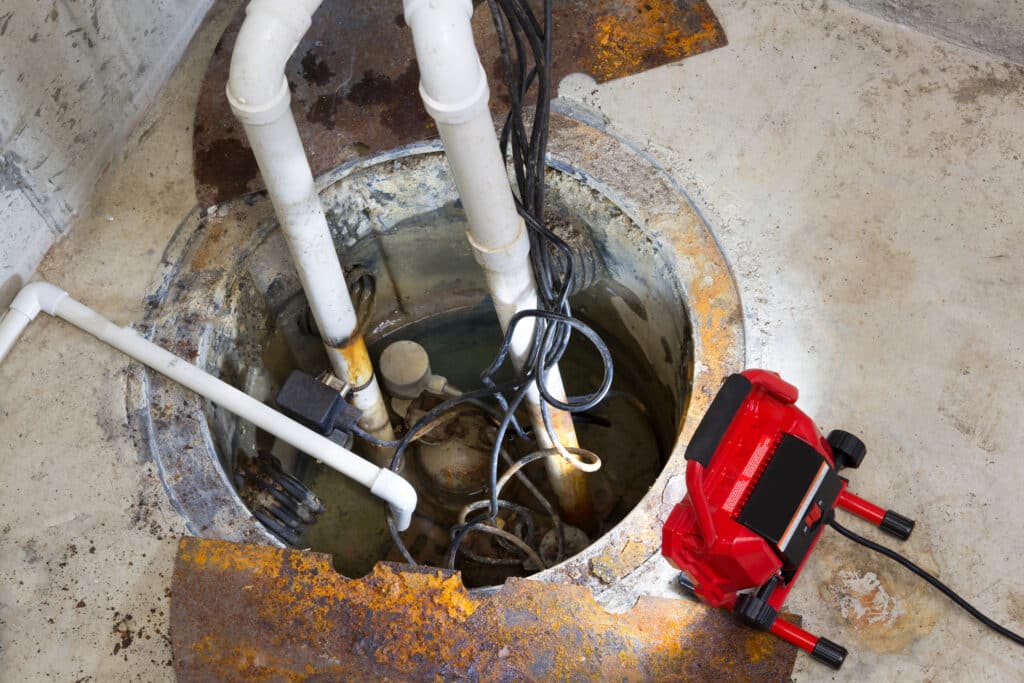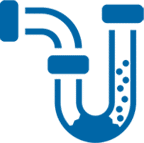Why You Should Schedule a Sump Pump Inspection This Winter
Sump pump inspection is essential for protecting your home, especially during winter. Cold temperatures can cause sump pump components to freeze, leading to malfunctions when you need them most. If your pump stops working, excess water can accumulate in your basement or crawl space, leading to serious issues like flooding, mold growth, and structural damage.
Winter conditions in Norman, OK, can be unpredictable, with occasional freezing temperatures that put extra strain on plumbing systems. A well-maintained sump pump inspection is your first line of defense against water damage, ensuring that melting snow, heavy rainfall, or groundwater seepage doesn’t cause unexpected problems.
By scheduling an inspection with Benjamin Franklin Plumbing of Oklahoma City, you can catch potential issues early and prevent costly repairs. Professional plumbers will check for common winter-related problems, such as frozen discharge lines, clogged pump intakes, and faulty float switches. Ensuring your sump pump is in peak condition now can save you from major headaches when spring arrives.
In this article, we’ll explore how winter affects your sump pump, the warning signs that it needs maintenance, and why professional inspections are the best way to ensure your system functions properly all season long.
How Winter Affects Your Sump Pump
Winter weather can have a significant impact on how well your sump pump inspection goes and how effectively the system operates. Cold temperatures, ice buildup, and power outages can lead to failures if your sump pump isn’t properly maintained. Understanding these risks can help homeowners in Norman, OK, take preventive action before problems arise.
One of the biggest winter-related issues is frozen discharge lines. When temperatures drop, any standing water in the discharge pipe can freeze, blocking the flow of water. If this happens, your sump pump will continue running, but the water will have nowhere to go. Over time, this can cause the pump to overheat or burn out, leading to costly repairs or replacements.
Another common problem is power failures due to winter storms. Heavy snowfall and ice can knock out electricity, leaving your sump pump inoperable. If your home relies on a sump pump to keep water out, a backup battery or water-powered sump pump is essential for protection during outages.
Additionally, cold temperatures can cause mechanical parts to stiffen or fail. Rubber seals, float switches, and check valves can become brittle in freezing weather, reducing efficiency and potentially leading to system failure. Regular sump pump inspections help detect these issues early, ensuring that your system is prepared for winter’s challenges.
Taking preventative measures, such as insulating discharge lines, testing your pump before extreme cold sets in, and ensuring your home has backup power, can keep your sump pump working properly all season long.

Signs Your Sump Pump Needs an Inspection
A sump pump is designed to keep your basement or crawl space dry, but like any mechanical system, it can develop problems over time. Recognizing the warning signs that your pump needs a sump pump inspection can help prevent costly water damage, especially during the winter months in Norman, OK.
One of the most noticeable signs of trouble is unusual noises. A well-functioning sump pump should operate quietly. If you hear grinding, rattling, or gurgling sounds, it could indicate worn-out parts, debris buildup, or a failing motor. Ignoring these noises may lead to pump failure at the worst possible time.
Another red flag is a sump pump that runs constantly or not at all. If your pump cycles on and off too frequently, it may be struggling to keep up due to a stuck float switch or an overwhelmed system. On the other hand, if your sump pump doesn’t turn on when water levels rise, it could be a sign of electrical failure or a clogged intake.
Slow drainage or standing water in the sump pit is another clear indicator that your system isn’t working correctly. A blockage in the pump or discharge line can prevent water from exiting your home properly. If left unaddressed, this can lead to basement flooding.
Finally, bad odors or mold growth near your sump pump suggest that stagnant water is accumulating. This can create a breeding ground for bacteria and mold, affecting indoor air quality. Scheduling a professional sump pump inspection can identify and resolve these issues before they escalate.
What Happens During a Sump Pump Inspection?
A professional sump pump inspection ensures your system is functioning correctly and can handle excess water during winter. Homeowners in Norman, OK, benefit from routine inspections to prevent unexpected failures that could lead to costly water damage.
During an inspection, a plumber will check for debris and clogs in the sump pit. Dirt, small rocks, and other obstructions can interfere with the pump’s ability to remove water efficiently. Cleaning out the sump pit and pump intake helps maintain smooth operation.
Next, the technician will test the float switch and backup battery. The float switch activates the pump when water levels rise, so if it’s stuck or malfunctioning, the pump may not turn on when needed. The backup battery is also checked to ensure it provides power during winter storms or outages, which are common causes of sump pump failure.
Another key step is examining the discharge line. If the pipe is clogged or frozen, water has nowhere to go, increasing the risk of flooding. The plumber will ensure the line is clear and positioned correctly to prevent freezing issues.
Finally, the plumber will inspect seals, electrical connections, and overall pump performance. Any worn-out or damaged components can be repaired or replaced to keep the sump pump in peak condition. Regular inspections help homeowners avoid emergency repairs and ensure their sump pump is ready for winter challenges.
The Dangers of a Failing Sump Pump in Winter
A malfunctioning sump pump can put your home at serious risk, especially during the winter months. Freezing temperatures and heavy rainfall can increase the chance of flooding, making a sump pump inspection essential for preventing costly damage. Homeowners in Norman, OK, should be aware of the dangers of a failing sump pump and take action before problems arise.
One of the most immediate risks is basement flooding. If your sump pump stops working due to mechanical failure or a frozen discharge line, water can quickly accumulate in your basement or crawl space. Even a small amount of standing water can lead to expensive repairs and damage to flooring, walls, and stored belongings.
Another major concern is mold growth and poor indoor air quality. Excess moisture creates the perfect environment for mold and mildew, which can spread quickly and cause health issues, especially for those with allergies or respiratory conditions. Mold remediation can be costly, making prevention through proper sump pump inspections the best approach.
Structural damage is also a possibility. When water seeps into a home’s foundation, it can weaken concrete and lead to cracks. Over time, this can compromise the stability of your home, requiring expensive repairs. Regular sump pump inspections help catch minor issues before they lead to severe structural damage.
Lastly, electrical hazards can occur when water and wiring mix. If flooding reaches electrical outlets or appliances, there is a heightened risk of short circuits and fires. Ensuring your sump pump is in top condition can help protect your home and your family’s safety during the winter months.
Preventative Maintenance Tips for Your Sump Pump
Regular maintenance is key to keeping your sump pump in top condition, especially during winter. A sump pump inspection can identify potential issues, but homeowners in Norman, OK, can also take preventative measures to ensure their system works efficiently when needed most.
One of the most important steps is testing your sump pump regularly. Pour a bucket of water into the sump pit and check if the pump activates properly. If it doesn’t turn on or struggles to drain the water, it may need professional attention.
Keeping the discharge line clear is also crucial. Snow, ice, and debris can block the line, causing water to back up and freeze. To prevent this, ensure the discharge pipe is positioned at a downward angle and insulated if necessary. A plumber can install a discharge extension to help direct water away from your home.
Installing a backup power source can protect against pump failure during power outages. A battery backup system or a water-powered backup pump ensures your sump pump continues working even if electricity is lost due to winter storms.
Lastly, clean the sump pit and pump components. Over time, dirt and debris can clog the intake, reducing efficiency. Wipe down the pump, remove any buildup, and check for worn-out parts. Scheduling a professional sump pump inspection at least once a year can help extend the lifespan of your system and prevent unexpected failures.
Why Winter is the Best Time for an Inspection
Winter may not seem like the ideal season for home maintenance, but it’s actually the perfect time to schedule a sump pump inspection. Homeowners in Norman, OK, can take advantage of this slower season to ensure their sump pump is in top condition before spring rains and snowmelt increase the risk of basement flooding.
One key reason to schedule an inspection now is fewer emergency service calls. Plumbing companies are often busier in spring and summer when heavy rains expose sump pump failures. By booking an inspection in winter, you can avoid long wait times and ensure your pump is prepared before it’s needed most.
Another benefit is early detection of winter-specific problems. Cold temperatures can cause discharge lines to freeze, float switches to stick, and mechanical parts to become brittle. A professional plumber can identify these issues and make necessary adjustments before they lead to serious failures.
Additionally, winter storms can cause unexpected power outages, which can leave your home vulnerable to flooding. An inspection ensures your backup battery or alternative power source is fully functional, providing peace of mind during harsh weather conditions.
Finally, getting ahead of maintenance now means you’re ready for spring thaw and heavy rains. As temperatures rise, melting snow and seasonal downpours can overwhelm an inefficient or failing sump pump. A thorough winter inspection ensures your system is prepared for the months ahead, reducing the risk of unexpected breakdowns and costly repairs.
How Professional Plumbers Help Keep Your Sump Pump Running
While regular homeowner maintenance is important, a professional sump pump inspection provides a more thorough evaluation of your system. Certified plumbers have the experience and tools to detect issues that may go unnoticed, ensuring your sump pump functions efficiently throughout winter in Norman, OK.
One of the biggest advantages of hiring a plumber is their expertise in diagnosing problems. They can identify worn-out parts, clogged intakes, or faulty float switches before they lead to major failures. Many sump pump issues develop gradually, and a trained professional can catch them early, preventing costly repairs down the road.
Plumbers also have specialized tools for cleaning and testing sump pumps. They use high-pressure water jets to clear debris from discharge lines and advanced diagnostic equipment to test the pump’s motor and electrical connections. This ensures your sump pump is working at peak performance and is ready to handle excess water when needed.
Another benefit is ensuring compliance with local plumbing codes. Professional plumbers understand the latest regulations and can verify that your sump pump system is installed correctly. They can also recommend improvements, such as installing a backup battery or upgrading to a more efficient pump, to enhance your home’s flood protection.
By scheduling routine inspections, you gain peace of mind knowing your sump pump is in expert hands. A professional plumber will not only fix existing problems but also provide preventative maintenance tips to extend the lifespan of your system, ensuring your home stays dry and protected all winter long.
Why Choose Benjamin Franklin Plumbing of Oklahoma City?
When it comes to protecting your home from water damage, choosing a trusted professional for your sump pump inspection is essential. Benjamin Franklin Plumbing of Oklahoma City has the expertise, experience, and dedication to ensure your sump pump is in peak condition, especially during the winter months in Norman, OK.
One of the key benefits of working with Benjamin Franklin Plumbing of Oklahoma City is their comprehensive sump pump inspection process. Their skilled plumbers thoroughly examine every component of your sump pump system, from the pump motor to the float switch and discharge line. This ensures your sump pump is ready to handle excess water, even in freezing temperatures.
Reliability is another major reason to schedule your sump pump inspection with a professional. A malfunctioning sump pump can cause unexpected basement flooding, mold growth, and costly structural damage. By choosing an experienced plumbing service, you can rest assured that your system is functioning correctly and efficiently.
In addition to expert service, Benjamin Franklin Plumbing of Oklahoma City offers preventative sump pump inspections to help homeowners avoid emergency repairs. Routine inspections can identify potential issues early, such as clogged discharge lines or worn-out parts, preventing costly breakdowns in the future.
With a reputation for quality workmanship and excellent customer service, Benjamin Franklin Plumbing of Oklahoma City is the go-to choice for professional sump pump inspections in Norman, OK. Don’t wait until spring to discover your sump pump isn’t working, schedule an inspection today to ensure your home stays protected all winter long.

FAQ Section
1. How often should I schedule a sump pump inspection?
It’s recommended to schedule a sump pump inspection at least once a year. Many homeowners choose to have their system inspected in late fall or early winter to ensure it’s ready for melting snow and spring rains. However, if you experience frequent heavy rain or flooding, a mid-year inspection may also be beneficial.
2. Can I inspect my sump pump myself?
Homeowners can perform basic maintenance, such as testing the pump by pouring water into the pit and checking for unusual noises. However, a professional sump pump inspection is necessary to assess electrical connections, motor function, and discharge line efficiency. Plumbers have specialized tools to detect hidden issues that may not be visible during a DIY check.
3. What is the average lifespan of a sump pump?
Most sump pumps last between 7 to 10 years, depending on usage and maintenance. Regular sump pump inspections help extend the lifespan of your system by identifying wear and tear before major failures occur.
4. What should I do if my sump pump stops working in winter?
If your sump pump fails, check for a tripped circuit breaker, a frozen discharge line, or a clogged intake. If the issue isn’t obvious, call a professional for an emergency sump pump inspection. In the meantime, use a wet vacuum or backup pump to remove standing water if possible.
5. How much does a sump pump inspection cost?
The cost of a sump pump inspection varies based on location, system complexity, and any necessary repairs. To get an accurate estimate, contact Benjamin Franklin Plumbing of Oklahoma City for a consultation.
















